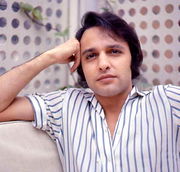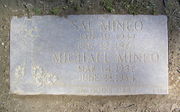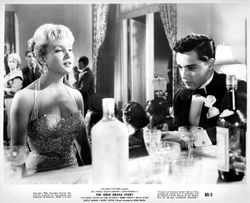Sal Mineo
| Sal Mineo | |
|---|---|
 Mineo in 1973, by Allan Warren |
|
| Born | Salvatore Mineo, Jr. January 10, 1939 , USA |
| Died | February 12, 1976 (aged 37) , USA |
| Other names | The Switchblade Kid[1] |
| Website | |
| http://www.salmineo.com | |
Salvatore Mineo, Jr. (January 10, 1939 – February 12, 1976), better known as Sal Mineo, was an American film and theatre actor, best known for his performance opposite James Dean in the film Rebel Without a Cause.[2]
Contents |
Early career
Mineo was born in The Bronx, the son of Sicilian coffin makers. His mother enrolled him in dancing and acting school at an early age.[3] He had his first stage appearance in The Rose Tattoo (1951),[2] a play by Tennessee Williams. He also played the young prince opposite Yul Brynner in the stage musical The King and I. Brynner took the opportunity to help a young Mineo better himself as an actor.[1]
After film and television appearances, his breakthrough was Rebel Without A Cause,[2] in which he played John "Plato" Crawford, the sensitive teenager smitten with Jim Stark (played by James Dean). His performance resulted in an Academy Award nomination for best supporting actor, and his popularity quickly developed.[1] Mineo's biographer, Paul Jeffers, recounted that Mineo received thousands of letters from young female fans, was mobbed by them at public appearances and further wrote, "He dated the most beautiful women in Hollywood and New York."[4]

Mineo played a Mexican boy in Giant (1956), but many of his subsequent roles were variations of his role in Rebel Without a Cause, and he was typecast as a troubled teen.[5] In the Disney adventure Tonka, for instance, Mineo starred as a young Sioux named White Bull who traps and domesticates a clear-eyed, spirited wild horse named "Tonka" who becomes the famous Comanche.
In his book, Multiculturalism And The Mouse: Race and Sex in Disney Entertainment (2006), Douglas Brode states that the casting of Mineo as White Bull again "ensured a homosexual subtext". By the late 1950s the actor was a major celebrity, sometimes referred to as the "Switchblade Kid" - a nickname he earned from his role as a criminal in the movie Crime in the Streets.[1]
In 1957, Mineo made a brief foray into pop music by recording a handful of songs and an album. Two of his singles reached the Top 40 in the United States Billboard Hot 100.[6] The more popular of the two, "Start Movin' (In My Direction)", reached #9 on Billboard's pop chart. It sold over one million copies, and was awarded a gold disc.[7] He starred as drummer Gene Krupa in the movie The Gene Krupa Story, co-starring Susan Kohner, James Darren, and Susan Oliver, and directed by Don Weis.
Mineo made an effort to break his typecasting. His acting ability and exotic good looks earned him roles as a Native American boy in Tonka, and as a Jewish emigrant in Otto Preminger's Exodus, for which he won a Golden Globe Award and received another Academy Award nomination as Best Supporting Actor.
Attempted resurgence
By the early 1960s, he was becoming too old to play the type of role that had made him famous and was not considered appropriate for leading roles. He auditioned for David Lean's film Lawrence of Arabia but was not hired.[3] Mineo was baffled by his sudden loss of popularity, later saying "One minute it seemed I had more movie offers than I could handle, the next, no one wanted me." He did appear on The Patty Duke Show in its second season (1964). The episode was titled Patty Meets a Celebrity.
His role as a stalker in Who Killed Teddy Bear?, co-starring Juliet Prowse, did not seem to help. Although his performance was praised by critics, he found himself typecast anew, now as a deranged criminal. (He never entirely escaped this; one of his last roles was a guest spot on the 1975 TV series S.W.A.T. playing a Charles Manson-like cult leader.) He returned to the stage to produce the 1971 gay-themed Fortune and Men's Eyes (starring Don Johnson). The play garnered positive reviews in Los Angeles, but, was panned during its New York run, and its expanded prison rape scene was criticized as excessive and gratuitous. A small role in Escape from the Planet of the Apes (1971) as chimpanzee Dr. Milo would be Mineo's last movie appearance. In 1973, Mineo appeared as Gamal Zaki, assistant to the president of a Middle Eastern country, who faces an assassination threat in the episode "A Case of Immunity" on NBC crime drama, Columbo, starring with Peter Falk, and Hawaii Five-O starring Jack Lord in 1974.
Death

By 1976 Mineo's career had begun to turn around.[8] Playing the role of a homosexual burglar in a San Francisco run of the stage comedy P.S. Your Cat Is Dead, he received substantial publicity from many positive reviews and moved to Los Angeles with the play. Arriving home after a rehearsal on February 12, 1976, Mineo was stabbed to death in the alley behind his West Hollywood apartment building.[9] He was 37 years old. Mineo was stabbed once, not repeatedly as first reported, but the blade struck his heart, leading to immediate and massive internal bleeding.[10] Mineo was interred at the Gate of Heaven Cemetery in Hawthorne, New York.[11]
According to Warren Johansson and William A. Percy's Outing: Shattering the Conspiracy of Silence, he was murdered under circumstances that suggested "a homosexual motive." Despite a high-profile romance with actress Jill Haworth, Mineo identified himself as bisexual in a 1972 interview,[3] published after his death, but his biography notes that he had sexual relationships with men exclusively in his later years.
Arrest in Mineo's killing
A pizza deliveryman, Lionel Ray Williams, was sentenced to 57 years in prison for killing Mineo and committing 10 robberies in the same vicinity.[12] Although there was considerable confusion relating to what witnesses had seen in the darkness the night Mineo was murdered, it was later revealed that prison guards reportedly overheard Williams admitting to the crime.[8] Williams claimed he had no idea who Mineo was. Williams was paroled in the early 1990s, but was soon jailed again for criminal activity.[3]
Art
Sal Mineo was the model for Harold Stevenson's painting The New Adam. The painting is currently part of Guggenheim Museum's permanent collection,[13] and is considered "one of the great American nudes".[14]
Opera
Mineo's career included involvement with opera. On May 8, 1954, he portrayed the Page (lip-synching to the voice of mezzo-soprano Carol Jones) in the NBC Opera Theatre's production of Richard Strauss' Salome (in English translation), set to Oscar Wilde's play. Elaine Malbin performed the title role, and Peter Herman Adler conducted Kirk Browning's production.
In December 1972, Mineo stage directed Gian Carlo Menotti's The Medium,[15] in Detroit. Muriel Costa-Greenspon portrayed the title character, Madame Flora, and Mineo himself played the mute Toby.
Selected filmography
Feature films

| Year | Film | Role | Notes |
|---|---|---|---|
| 1955 | Rebel Without a Cause | John "Plato" Crawford | Nominated for an Academy Award for Best Supporting Actor |
| 1956 | Crime in the Streets | Angelo "Baby" Gioia, a.k.a. Bambino | |
| Somebody Up There Likes Me | Romolo | ||
| Giant | Angel Obregón II | ||
| Rock, Pretty Baby | Angelo Barrato | ||
| 1957 | Dino | Dino Minetta | |
| The Young Don't Cry | Leslie "Les" Henderson | ||
| 1958 | Tonka | White Bull | |
| 1959 | A Private's Affair | Luigi Maresi | |
| The Gene Krupa Story | Gene Krupa | ||
| 1960 | Exodus | Dov Landau | Golden Globe Award for Best Supporting Actor - Motion Picture, Nominated for an Academy Award for Best Supporting Actor |
| 1962 | Escape from Zahrain | Ahmed | |
| The Longest Day | Pvt. Martini | ||
| 1964 | Cheyenne Autumn | Red Shirt | |
| 1965 | The Greatest Story Ever Told | Uriah | |
| Who Killed Teddy Bear | Lawrence Sherman | ||
| 1969 | Krakatoa, East of Java | Leoncavallo Borghese | |
| 80 Steps to Jonah | Jerry Taggart | ||
| 1971 | Escape from the Planet of the Apes | Dr. Milo |
Footnotes
- ↑ 1.0 1.1 1.2 1.3 Bell, Rachael. "The Switchblade Kid: The Life and Death of Sal Mineo". http://www.trutv.com/library/crime/notorious_murders/celebrity/sal_mineo/2.html. Retrieved 2008-07-20
- ↑ 2.0 2.1 2.2 Holliday, Peter J.. "Mineo, Sal (1939-1976)". http://www.glbtq.com/arts/mineo_s.html. Retrieved 2008-07-20
- ↑ 3.0 3.1 3.2 3.3 Noe, Denise. "The Murder of Sal Mineo". http://crimemagazine.com/salmineo.htm. Retrieved 2008-07-20
- ↑ Jeffers, Paul (2000). Sal Mineo: His Life, Murder, and Mystery. New York: Carroll & Graf Publishers. ISBN 0786707771.
- ↑ Smith, Laura C.. "Untimely End for a 'Rebel'". http://www.ew.com/ew/article/0,,296009,00.html. Retrieved 2008-07-20
- ↑ salmineo.com. "Sal Mineo Mini biography". http://www.salmineo.com/biopt2.html. Retrieved 2008-07-25.
- ↑ Murrells, Joseph (1978). The Book of Golden Discs (2nd ed.). London: Barrie and Jenkins Ltd. p. 94. ISBN 0-214-20512-6.
- ↑ 8.0 8.1 Ellis, Chris; Julie Ellis (2005). The Mammoth Book of Celebrity Murder. New York: Carroll & Graf Publishers. pp. 419–422. ISBN 0786715685.
- ↑ Obituary Variety, February 18, 1976, page 126.
- ↑ Rachael Bell (2008). "The Switchblade Kid: The Life and Death of Sal Mineo". TruTV. Turner Broadcasting System, Inc.. http://www.trutv.com/library/crime/notorious_murders/celebrity/sal_mineo/6.html. Retrieved 2008-07-12.
- ↑ Sal Mineo at Find a Grave
- ↑ Los Angeles Times. "Actor Sal Mineo Is Stabbed to Death". http://articles.latimes.com/2006/feb/12/local/me-a2anniversary12. Retrieved 2008-07-20
- ↑ Mann, Ted. "The New Adam". http://www.guggenheimcollection.org/site/artist_work_md_200612_1.html. Retrieved 2008-07-20
- ↑ Vogel, Carol (2005-09-30). "Exposure for a Nude". The New York Times. http://www.nytimes.com/2005/09/30/arts/design/30voge.html. Retrieved 2008-07-22.
- ↑ Stevenson, Harold. "The New Adam Article". http://www.salmineo.com/news/newadamarticle.html. Retrieved 2008-07-22.
References
- Frascella, Lawrence and Weisel, Al Live Fast, Die Young: The Wild Ride of Making Rebel Without a Cause (Touchstone, 2005) ISBN 0-7432-6082-1
- Gilmore, John, Laid Bare: A Memoir of Wrecked Lives and the Hollywood Death Trip (Amok Books, 1998) ISBN 1-878923-08-0
- Jeffers, H. Paul, Sal Mineo: His Life, Murder, and Mystery (New York: Caroll & Graf, 2000) ISBN 0-7867-0777-1
- Johansson, Warren & Percy, William A. Outing: Shattering the Conspiracy of Silence. (Harrington Park Press, 1994), p. 91.
External links
- Sal Mineo at the Internet Movie Database
- Sal Mineo at Find a Grave
- Sal Mineo at the Internet Broadway Database
- Sal Mineo at the Internet Off-Broadway Database
- Hadleigh interview with Sal Mineo, 1972
|
|||||